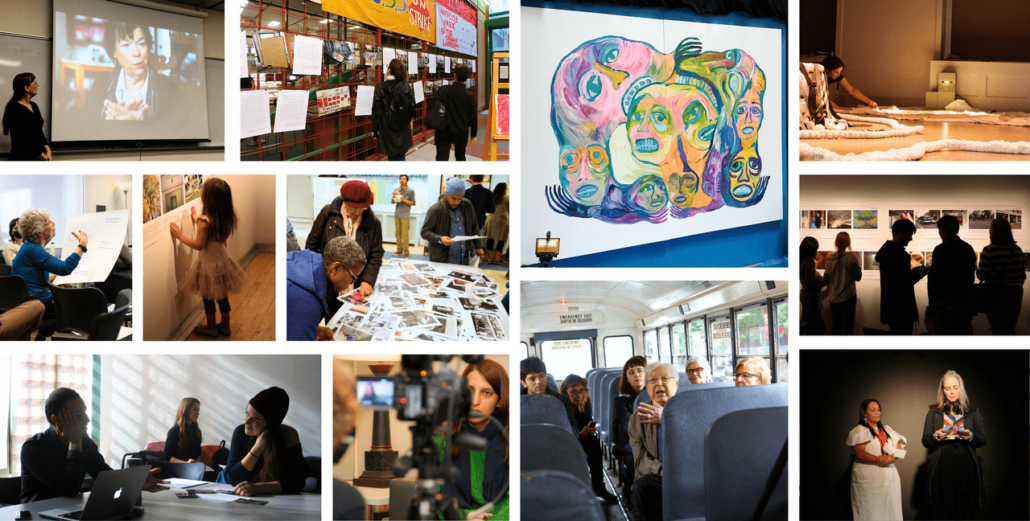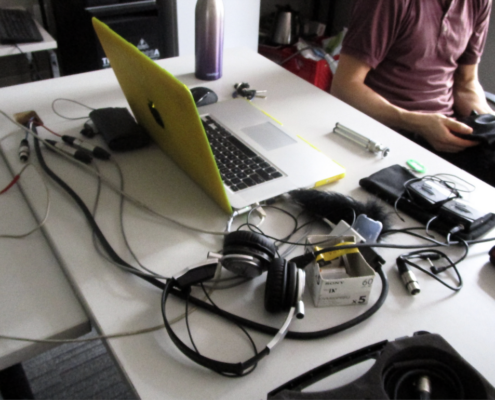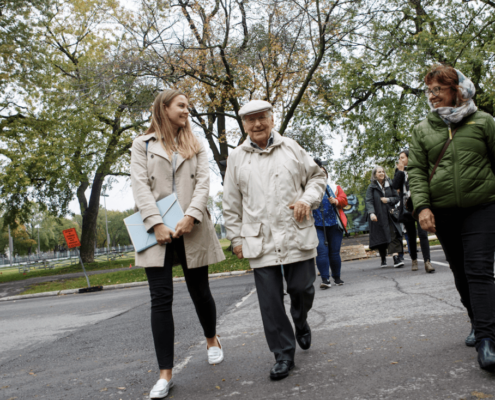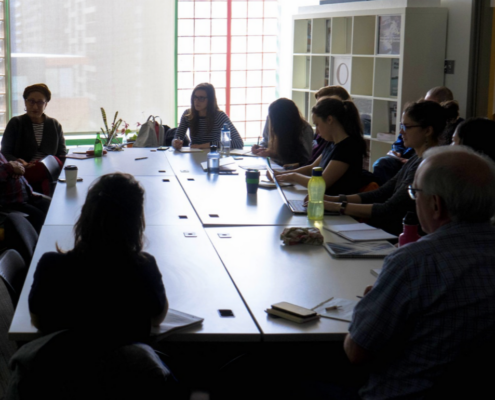From telling the stories of a changing neighbourhood, to understanding and reclaiming experiences of displacement, oral history allows individuals to express and record their stories through collaboration. This practice offers many possibilities for understanding how people remember the past, as well as how they recognize place, belonging, and themselves.
Finding a starting place can be tricky. How does one even begin an oral history project? What does it mean to listen deeply and share authority? How can life story interviews be beneficial learning tools?
Whether you are an educator, student, or community member, the possibilities of oral history are vast. Below you will find comprehensive guides and resources on how to work with oral history interviews, ranging from how to develop an original oral history project, engage with existing interviews, and ways to include oral history in a classroom setting.
In addition to our development guide, educators will also find a comparative list of syllabi, online resources, and details on how you can connect your cohort with COHDS.
WHAT IS ORAL HISTORY?
Oral history is an academic method of understanding the past through living memory that is grounded in ethical practices and shared authority. In practice, this looks like the interviewer and interviewee making informed choices together, and working collaboratively to help one individual (the interviewee) make sense of the past, reflect on it as well as how it manifests in the present.
This entails thinking intentionally both about the work you conduct and the relationships you cultivate through your work. Oral history holds the ability to creatively and methodically connect us to our subjects, but also connect us as storytellers, both in the present and across time.
Working with oral history can look like: developing a project from the ground up; working with existing archives and interviews; embarking on oral history walking tours; learning about the technology available to record living memory; engaging with different research theory and methodology; and/or attending workshops to harness the skills to make the most out of your ideas.
The practice of oral history goes far beyond asking questions, receiving answers, and disseminating the research. In the process of connecting with the past, oral historians first make space for one another in the present.
SHARING AUTHORITY
Expanding on Michael Frisch’s term “shared authority,” Steven High suggests that sharing authority entails “the cultivation of trust, the development of collaborative relationships, and shared decision-making.” This is one of the pilars of oral history methodology.
When you are developing your own oral history project, acknowledging and intentionally developing a collaborative relationship between you and your interviewee is vital; it is a continual and co-creative process. In practice, this looks like allocating time and energy to working with your interview partners both within the interview space and outside of it.
When conducting research with existing interviews, it is important to work a layer of added reflection into the research process by paying particular attention to the context surrounding the creation of the interviews. In this case, the collaboration is between you, the oral historian who conducted the interview, and the interviewee who is sharing their stories. That said, you may not have access to the interviewers nor to the interviewees. It’s always best to use interviews which interviewees have agreed to make public.
DEEP LISTENING
Deep listening refers to the presence you create in the interview space. In practice, this looks like being attentive to the dynamics that emerge during the interview or taking into consideration your position as a listener, and listening for things like emotions, tensions, and silences. These are all things that often go beyond the spoken word. It also means acknowledging the complex and often laborious nature of both interviewing and remembering. Deep listening can also mean being attuned to your interviewee’s needs and offering to take a break during the interviews.
While specific to the interview process, a similar level of reflexivity is encouraged, and even crucial, when reusing existing sources.
ETHICS
Taking time to think through the ethical implications of an oral history project is a key component of the research development process. You can visit our ethics page for an in-depth look at the core ethics principles, the ethics approval process, and examples of consent forms. In short, at the forefront of any oral history project are four core ethics principles:
1. Informed consent
Informed consent refers to how you and your interviewee set the terms of the interview and its use thereafter. Before any interview takes place, the interviewee must agree to participate (typically in the form of written or recorded verbal consent), and must be informed on how their testimony will be further used.
2. Mitigation of harm
Mitigation of harm refers to the efforts that you take as a researcher to ensure the emotional wellbeing of your interview partner. This can include creating an outline of local counselling and mental health services, following correct protocol when interviewee’s decide to remain anonymous, and sending them a thank you note after the interviews have finished.
3. Right of withdrawal
Right of withdrawal honours the choice interviewee’s may make to end the interview at any moment. This is something you should remind your interviewee in the earliest steps of your project so that they are aware their participation is contingent on their terms.
4. Shared Authority
As mentioned above, interviewees retain rights over material in perpetuity, meaning that the consent process is one that is ongoing, and continues into the interview space, as well as long after the interview has finished. In practice, your consent forms must reflect this. If you are planning to interview someone in an institutional setting, like for a class project, you will require formal ethics approval.
MAPPING A PROJECT
Below you will find a suggested approach for mapping out an oral history project. These steps are relevant should you choose to develop a project from the ground up or to reuse existing interviews.
1. Plan
Imagine the many possibilities of what you would like your project to explore and what shape you wish your interview to take. If you are reusing existing interviews, at this step you will locate your interview(s) or interview collection through exploring different websites, archives, and databases. At this stage you will want to consider your primary research questions, who you would like to interview, the ethics protocol involved with your project and the scope of your project.
2. Interview
At this stage you will either conduct your own or listen to existing interviews as a way of connecting with your sources. Though some scholars prefer working with transcripts, listening to interviews gives you insight into other dimensions of communication including tone, pauses and emotion that are not evident when reading a transcript.
3. Reflect
Reflections are a key component of working with oral history. Writing a short reflection can be a good way to capture what struck you with the interviews, whether you are conducting them or listening to existing ones. The post-interview reflection should take place ideally within 24 hours of conducting or listening to an interview. Your reflection will give you a chance to record your feelings about the interview, observations you made, and further questions you may have. This step offers a chance for new metadata to be created that is often absent from your recordings.
4. Process
Ensuring that all the files are securely stored and well organized, including any consent or ethics forms, is key. You can also transcribe interviews in part or in totality; this can help you pay attention to certain aspects of your interviews. When reusing existing interviews, pay attention to themes or topics that may arise.
5. Share/Create
Oral history projects can take many different shapes. This can range from traditional forms like papers, articles, books, to podcasts, films, walking tours, performances, and other mediums of visual and material art. For examples of different types of research creation projects see our Research/Creation page.
It is also worth considering whether you would like to donate your own interviews to an archive. This can be a beneficial step as it makes interviews accessible to the community from which the interview emerges. Before you choose to donate your interview, you must refer back to your interviewee and consent forms to make sure a donation is possible and the conditions under which it could happen. To read more about archival practices visit our Archives page.




